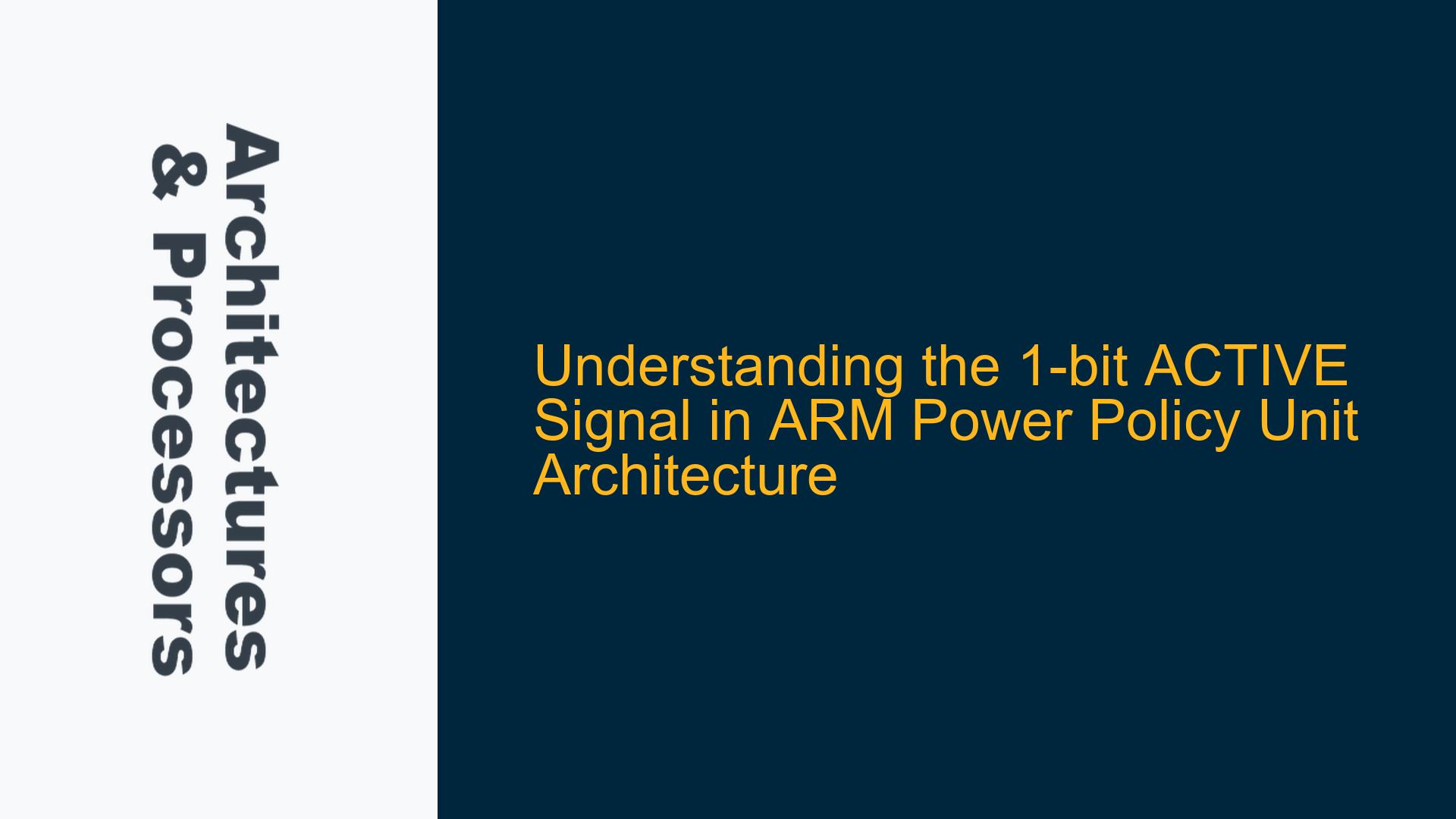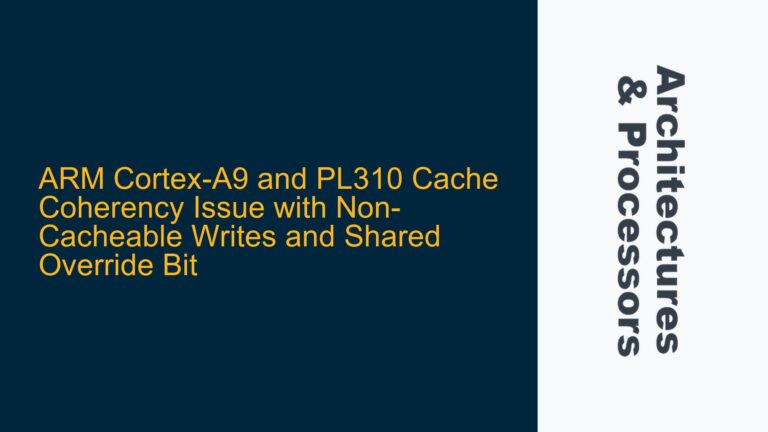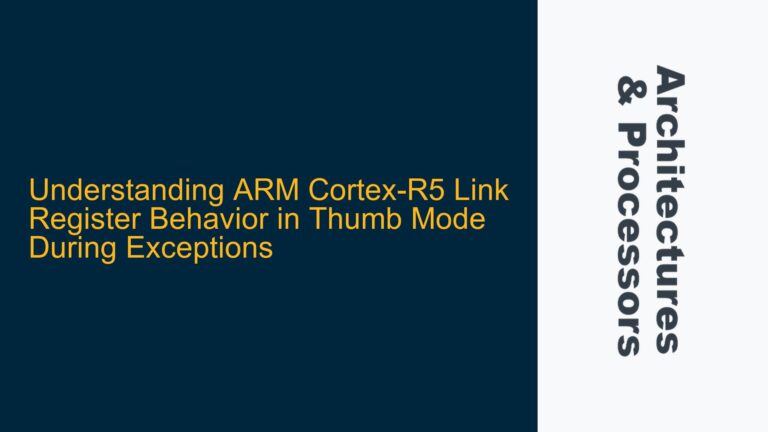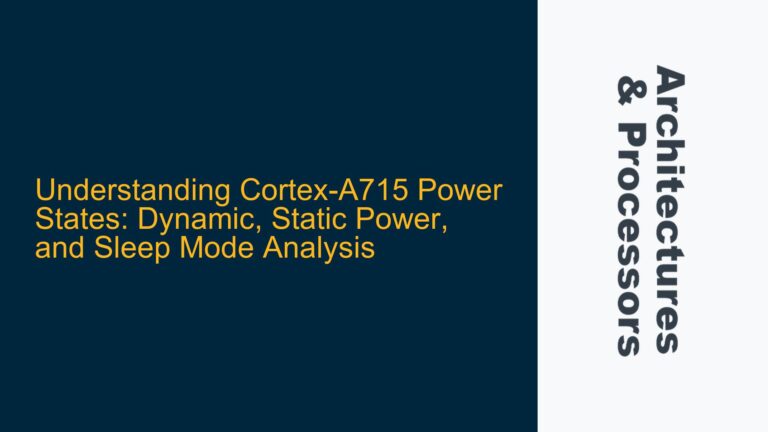ARM Power Policy Unit Q-Channel ACTIVE Signal and Power Mode Mapping
The ARM Power Policy Unit (PPU) architecture is a critical component in modern ARM-based SoCs, enabling efficient power management by controlling transitions between different power modes. The Q-Channel interface, a key part of the PPU, includes a 1-bit ACTIVE signal that plays a pivotal role in managing these transitions. However, the mapping of this 1-bit ACTIVE signal to the various power modes described in the ARM PPU Architecture Specification (Section 3.3.2) can be ambiguous, especially when considering the complexity of power mode transitions.
The ACTIVE signal is a binary signal, meaning it can only be in one of two states: logic high (1) or logic low (0). This simplicity contrasts with the multiple power modes (e.g., ON, OFF, RETENTION, and other intermediate states) that the PPU must manage. The challenge lies in understanding how a single binary signal can effectively represent and control transitions between these diverse power modes. This issue is further complicated by the fact that power mode transitions are not always instantaneous and may involve intermediate states or sequences that are not explicitly represented by the ACTIVE signal alone.
To fully grasp the relationship between the ACTIVE signal and power modes, it is essential to delve into the underlying mechanisms of the Q-Channel interface, the role of the ACTIVE signal in power mode transitions, and how the PPU interprets this signal in conjunction with other signals and internal state machines.
ACTIVE Signal Interpretation and Power Mode Transition Logic
The ACTIVE signal in the Q-Channel interface is not an isolated signal but part of a broader handshake mechanism that includes other signals such as REQ, ACK, and PWR_OK. The ACTIVE signal primarily indicates whether the associated power domain should be in an active state (logic high) or a low-power state (logic low). However, the actual power mode transitions are governed by a combination of the ACTIVE signal, the PPU’s internal state machine, and the system’s power management policies.
When the ACTIVE signal is high, the PPU interprets this as a request to transition the power domain to an active state, typically the ON mode. Conversely, when the ACTIVE signal is low, the PPU initiates a transition to a low-power state, which could be OFF, RETENTION, or another intermediate state depending on the system configuration. The specific power mode transition depends on the PPU’s configuration, the current power state, and the timing of the ACTIVE signal change.
For example, if the ACTIVE signal transitions from high to low, the PPU may first transition the power domain to a RETENTION mode to preserve critical data before fully powering down to the OFF mode. Similarly, when the ACTIVE signal transitions from low to high, the PPU may sequence through intermediate states to ensure a stable and controlled power-up process. These transitions are managed by the PPU’s internal state machine, which interprets the ACTIVE signal in the context of the system’s power management requirements.
The ACTIVE signal’s role in power mode transitions is further influenced by the Q-Channel’s handshake protocol. The REQ and ACK signals are used to synchronize power mode transitions between the PPU and the power domain, ensuring that transitions occur only when both the PPU and the power domain are ready. The ACTIVE signal, in conjunction with these handshake signals, provides a robust mechanism for managing power mode transitions while minimizing the risk of errors or instability.
Debugging and Resolving ACTIVE Signal and Power Mode Mapping Issues
When encountering issues related to the ACTIVE signal and power mode mapping, a systematic approach is required to identify and resolve the underlying causes. The first step is to verify the configuration of the PPU and the Q-Channel interface, ensuring that the ACTIVE signal is correctly connected and that the PPU’s internal state machine is properly configured to interpret the signal. This involves reviewing the PPU’s configuration registers, the power management policies, and the timing of the ACTIVE signal transitions.
Next, it is essential to analyze the timing of the ACTIVE signal in relation to the REQ and ACK signals. Misalignment or incorrect sequencing of these signals can lead to improper power mode transitions. Using simulation tools, designers can trace the timing of these signals and identify any discrepancies that may be causing issues. Additionally, it is important to verify that the power domain’s state machine is correctly responding to the ACTIVE signal and transitioning through the appropriate power modes.
In cases where the ACTIVE signal is not correctly mapped to the desired power modes, it may be necessary to adjust the PPU’s configuration or modify the power management policies. This could involve changing the timing of the ACTIVE signal transitions, reconfiguring the PPU’s internal state machine, or updating the system’s power management software. It is also important to consider the impact of these changes on other components in the system, ensuring that power mode transitions do not introduce instability or performance issues.
Finally, it is crucial to validate the corrected configuration through extensive simulation and testing. This includes running power mode transition tests, verifying the timing of the ACTIVE signal, and ensuring that the power domain transitions correctly between all supported power modes. By following these steps, designers can effectively debug and resolve issues related to the ACTIVE signal and power mode mapping in the ARM PPU architecture.
In conclusion, the 1-bit ACTIVE signal in the ARM Power Policy Unit’s Q-Channel interface plays a critical role in managing power mode transitions. While its binary nature may seem simplistic, its interpretation by the PPU’s internal state machine and its interaction with other signals in the Q-Channel interface enable it to effectively control complex power mode transitions. By understanding the underlying mechanisms and following a systematic approach to debugging and resolving issues, designers can ensure that the ACTIVE signal is correctly mapped to the desired power modes, enabling efficient and reliable power management in ARM-based SoCs.






